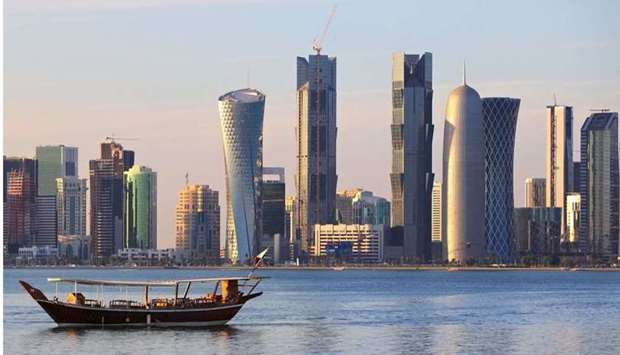Qatar’s public debt as a percentage of the GDP is set to decline to 55.4 in 2025 from 65.8 this year, researcher FocusEconomics said in a report.
Next year it will be 61.7; 60 in 2023 and 57.7 in 2024, FocusEconomics said in its latest country update.
The country’s fiscal balance (as a percentage of the GDP) has been estimated at 1.8 in 2025 from 1.7 this year. Next year, it is estimated to rise to 2.2; 2.0 in 2023 and 1.9 in 2024.
Qatar’s current account balance (as a percentage of the GDP) has been estimated to scale up to 7.2 in 2025 from 4.5 this year. Next year, it will be 4.3; 4.4 in 2023 and 5.8 in 2024.
The country’s GDP per capita, according to FocusEconomics, will scale up to $71,681 in 2025 from $61,171 in 2021.
Next year, the country’s GDP may account for $64,268; $66,259 (2023) and $68,977 in 2024.
Qatar's economy is expected to maintain growth in the region of 2.5% to 2.7% until 2025, it said.
Qatar’s unemployment will remain a meagre 0.2% between 2021 and 2025, FocusEconomics said.
On Qatar’s economic outlook, activity appeared to be resilient in the first quarter.
The non-energy private sector PMI was well in expansionary territory, while industrial production data suggested the energy sector performed better compared to Q4, 2020.
Turning to Q2, industrial production expanded in annual terms in April. However, momentum in the non-energy sector seemed to ease early in the quarter amid the “progressive tightening” of restrictions to combat a second wave of Covid-19, with the private sector PMI declining in April and May.
More positively, the government began to loosen restrictions in four phases from May 28, which saw the PMI recover in June.
Qatar Petroleum’s recently completed bond sale should help Qatar boost its energy output in the coming years, with the government aiming to raise LNG production to 126mn tonnes per year by 2027, up from 77mn currently.
The economy is set to return to growth this year on stronger domestic and foreign demand. Investment in the energy sector should also aid activity.
However, the potential extension of restrictions and new variants of Covid-19 pose downside risks. FocusEconomics panelists see a 2.7% rise in GDP in 2021, which is down 0 2 percentage points from last month's forecast, before growth of 3.7% in 2022.
Inflation jumped to 2.5% in May from 1.0% in April. Price pressures should be notably higher this year than last due to higher food and energy costs, recovering activity and a supportive base effect. FocusEconomics panelists see consumer prices rising 1.4% in 2021, which is up 0.1 percentage points from last month's forecast. In 2022, it sees inflation averaging 2.4%.
Next year it will be 61.7; 60 in 2023 and 57.7 in 2024, FocusEconomics said in its latest country update.
The country’s fiscal balance (as a percentage of the GDP) has been estimated at 1.8 in 2025 from 1.7 this year. Next year, it is estimated to rise to 2.2; 2.0 in 2023 and 1.9 in 2024.
Qatar’s current account balance (as a percentage of the GDP) has been estimated to scale up to 7.2 in 2025 from 4.5 this year. Next year, it will be 4.3; 4.4 in 2023 and 5.8 in 2024.
The country’s GDP per capita, according to FocusEconomics, will scale up to $71,681 in 2025 from $61,171 in 2021.
Next year, the country’s GDP may account for $64,268; $66,259 (2023) and $68,977 in 2024.
Qatar's economy is expected to maintain growth in the region of 2.5% to 2.7% until 2025, it said.
Qatar’s unemployment will remain a meagre 0.2% between 2021 and 2025, FocusEconomics said.
On Qatar’s economic outlook, activity appeared to be resilient in the first quarter.
The non-energy private sector PMI was well in expansionary territory, while industrial production data suggested the energy sector performed better compared to Q4, 2020.
Turning to Q2, industrial production expanded in annual terms in April. However, momentum in the non-energy sector seemed to ease early in the quarter amid the “progressive tightening” of restrictions to combat a second wave of Covid-19, with the private sector PMI declining in April and May.
More positively, the government began to loosen restrictions in four phases from May 28, which saw the PMI recover in June.
Qatar Petroleum’s recently completed bond sale should help Qatar boost its energy output in the coming years, with the government aiming to raise LNG production to 126mn tonnes per year by 2027, up from 77mn currently.
The economy is set to return to growth this year on stronger domestic and foreign demand. Investment in the energy sector should also aid activity.
However, the potential extension of restrictions and new variants of Covid-19 pose downside risks. FocusEconomics panelists see a 2.7% rise in GDP in 2021, which is down 0 2 percentage points from last month's forecast, before growth of 3.7% in 2022.
Inflation jumped to 2.5% in May from 1.0% in April. Price pressures should be notably higher this year than last due to higher food and energy costs, recovering activity and a supportive base effect. FocusEconomics panelists see consumer prices rising 1.4% in 2021, which is up 0.1 percentage points from last month's forecast. In 2022, it sees inflation averaging 2.4%.


